Themed collection 2023 Journal of Materials Chemistry B Lunar New Year

Molybdenum disulfide (MoS2)-based nanostructures for tissue engineering applications: prospects and challenges
Prospects of MoS2 nanostructure-based scaffolds in tissue engineering with enhanced cellular response, immunomodulation, and antibacterial properties. An interdisciplinary and collaborative effort is crucial to perceive their clinical translation.
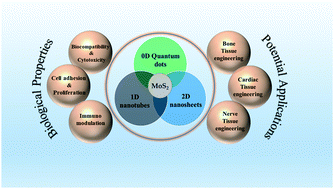
J. Mater. Chem. B, 2022,10, 2761-2780
https://doi.org/10.1039/D2TB00131D
Recent progress in tannic acid-driven antibacterial/antifouling surface coating strategies
Tannic acid-based bioinspired coating strategies for tethering functional materials or molecules on different medical substrates for resisting bacterial pathogens and fouling agents.

J. Mater. Chem. B, 2022,10, 2296-2315
https://doi.org/10.1039/D1TB02073K
Engineering strategies to achieve efficient in vitro expansion of haematopoietic stem cells: development and improvement
Schematic illustration of the 3D culture model including scaffold-based and scaffold-free systems for in vitro expansion of haematopoietic stem cells.
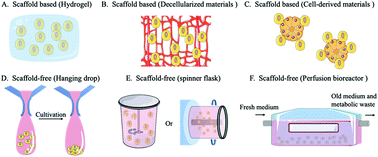
J. Mater. Chem. B, 2022,10, 1734-1753
https://doi.org/10.1039/D1TB02706A
A dynamic nano-coordination protein hydrogel for photothermal treatment and repair of infected skin injury
A dynamic nano-coordination photothermal hydrogel was successfully used as a highly adaptable and antibacterial wound dressing for infected skin injuries.
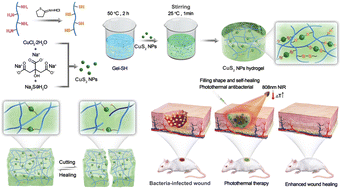
J. Mater. Chem. B, 2022,10, 8181-8185
https://doi.org/10.1039/D2TB01146H
A water-soluble thiophene-croconaine dye with a high molar extinction coefficient for NIR fluorescence imaging-guided synergistic photothermal/photodynamic therapy of cancer
A water-soluble thiophene-croconaine dye with a high molar extinction coefficient for NIR fluorescence imaging-guided synergistic photothermal/photodynamic therapy of cancer.

J. Mater. Chem. B, 2022,10, 9848-9854
https://doi.org/10.1039/D2TB01772E
Bioresource-derived colloidal nitrogen-doped graphene quantum dots as ultrasensitive and stable nanosensors for detection of cancer and neurotransmitter biomarkers
Microplasma synthesis of nitrogen-doped graphene quantum dots from chitosan usable for the selective detection of folic acid, uric acid, dopamine, and epinephrine.
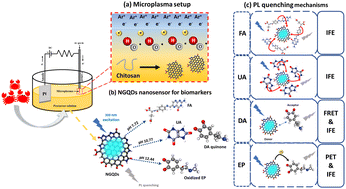
J. Mater. Chem. B, 2022,10, 9654-9661
https://doi.org/10.1039/D2TB01833K
A dual-targeting fluorescent probe for simultaneous and discriminative visualization of lipid droplets and endoplasmic reticulum
A single fluorescent probe (SF-probe) that can simultaneously and discriminatively visualize two organelles is a powerful tool to investigate their interaction in cellular processes.

J. Mater. Chem. B, 2022,10, 8875-8882
https://doi.org/10.1039/D2TB01536F
A diselenium-bridged covalent organic framework with pH/GSH/photo-triple-responsiveness for highly controlled drug release toward joint chemo/photothermal/chemodynamic cancer therapy
A novel joint chemo/photothermal/chemodynamic therapy was developed using a pH/GSH/photo triple-responsive 2D-covalent organic framework (Di-Se-Por) as a drug carrier for the passive target treatment of tumors with extraordinarily high efficiency.
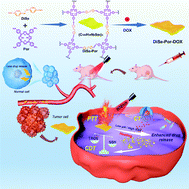
J. Mater. Chem. B, 2022,10, 7955-7966
https://doi.org/10.1039/D2TB01015A
A NIR-II light-modulated injectable self-healing hydrogel for synergistic photothermal/chemodynamic/chemo-therapy of melanoma and wound healing promotion
A novel NIR-II activatable multi-responsive self-healing hydrogel with inherent photothermal, chemodynamic, and antibacterial activity is developed for multimodal synergic melanoma therapy and promoting wound healing.
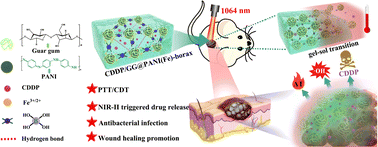
J. Mater. Chem. B, 2022,10, 7717-7731
https://doi.org/10.1039/D2TB00923D
An antioxidant nanodrug protects against hepatic ischemia–reperfusion injury by attenuating oxidative stress and inflammation
CeO2 and MnO2 nanocomposites, with advantages of high biocompatibility, passive liver-targeting and short-term metabolic excretion, have the capacity to scavenge ROS and regulate the inflammation to alleviate hepatic ischemia–reperfusion injury.
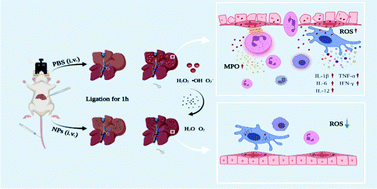
J. Mater. Chem. B, 2022,10, 7563-7569
https://doi.org/10.1039/D1TB02689E
Improving printability of hydrogel-based bio-inks for thermal inkjet bioprinting applications via saponification and heat treatment processes
A two-step bio-ink modification process developed in this work is a facile method to produce printable hydrogel-based bio-inks for inkjet bioprinting that can be potentially used for fundamental cell–cell and cell–material interaction studies.
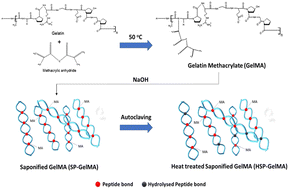
J. Mater. Chem. B, 2022,10, 5989-6000
https://doi.org/10.1039/D2TB00442A
In situ growth of WO3/BiVO4 nanoflowers onto cellulose fibers to construct photoelectrochemical/colorimetric lab-on-paper devices for the ultrasensitive detection of AFP
A dual-mode lab-on-paper device for sensitive photoelectrochemical/colorimetric sensing of AFP based on in situ grown WO3/BiVO4 heterojunctions onto cellulose fibers.
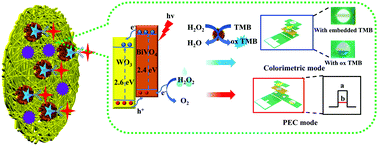
J. Mater. Chem. B, 2022,10, 4031-4039
https://doi.org/10.1039/D2TB00297C
Responsive hydrogel-based microneedle dressing for diabetic wound healing
A glucose-responsive insulin-releasing hydrogel microneedle dressing was developed with the aim to accelerate wound healing in type 1 diabetic mice.
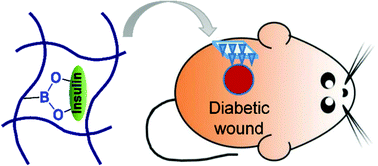
J. Mater. Chem. B, 2022,10, 3501-3511
https://doi.org/10.1039/D2TB00126H
Orange-red to NIR emissive carbon dots for antimicrobial, bioimaging and bacteria diagnosis
Schematic illustration of the preparation of Cur-NRCQDs with orange-red to NIR fluorescence. The Cur-NRCQDs showed excellent antibacterial effects on S. aureus and E.coli under PDT and have imaging applications.

J. Mater. Chem. B, 2022,10, 1250-1264
https://doi.org/10.1039/D1TB02457D
Highly stretchable, self-healable, and self-adhesive ionogels with efficient antibacterial performances for a highly sensitive wearable strain sensor
Gel-based strain sensors with multi-functional outstanding properties have gained considerable attention.

J. Mater. Chem. B, 2022,10, 1301-1307
https://doi.org/10.1039/D2TB00041E
Mitochondrion-targeting PEGylated BODIPY dyes for near-infrared cell imaging and photodynamic therapy
We report the synthesis of NIR-absorbing and mitochondrion-targeting BODIPY dyes, which exhibited high phototoxicity toward cancer cells while affording cell imaging.

J. Mater. Chem. B, 2022,10, 1196-1209
https://doi.org/10.1039/D1TB02393D
Ionic liquid exfoliated Ti3C2Tx MXene nanosheets for photoacoustic imaging and synergistic photothermal/chemotherapy of cancer
In this paper, a few layers of ionic liquid (IL)-Ti3C2Tx MXene nanosheets were synthesized using IL stripping technology and used in photoacoustic imaging and photothermal/chemotherapy synergistic therapy of cancer.
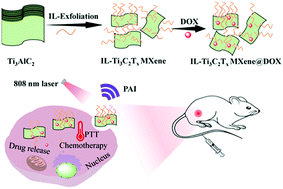
J. Mater. Chem. B, 2022,10, 1226-1235
https://doi.org/10.1039/D1TB01938D
A low-swelling and toughened adhesive hydrogel with anti-microbial and hemostatic capacities for wound healing
Hydrogel composed of Pluronic F127 diacrylate, quaternized chitosan diacrylate, silk fibroin, and tannic acid is able to maintain good tissue adhesion abilities for wound healing.
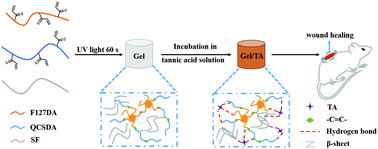
J. Mater. Chem. B, 2022,10, 915-926
https://doi.org/10.1039/D1TB01871J
Gradient adhesion modification of polyacrylamide/alginate–calcium tough hydrogels
A gradient adhesive–tough hydrogel without an obvious heterogeneous interface was constructed by on-side coordination-induced diffusion for application as a strain sensor to monitor human motions.

J. Mater. Chem. B, 2022,10, 757-764
https://doi.org/10.1039/D1TB02599F
Construction of a stereocomplex between poly(D-lactide) grafted hydroxyapatite and poly(L-lactide): toward a bioactive composite scaffold with enhanced interfacial bonding
Hydroxyapatite (HAP) grafted with poly( D-lactide) (PDLA) was incorporated into poly(L-lactide) (PLLA) to construct a stereocomplex, thus improving the interfacial bonding between PLLA and HAP like a zip-lock structure in a scaffold.
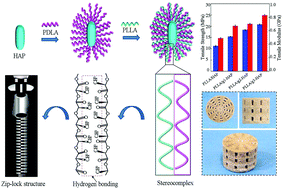
J. Mater. Chem. B, 2022,10, 214-223
https://doi.org/10.1039/D1TB02111G
About this collection
To mark the Lunar New Year, this web collection features 20 of the most popular articles published in Journal of Materials Chemistry B in 2022 by corresponding authors based in countries celebrating Lunar New Year.
Congratulations to all of the authors whose articles have been featured!